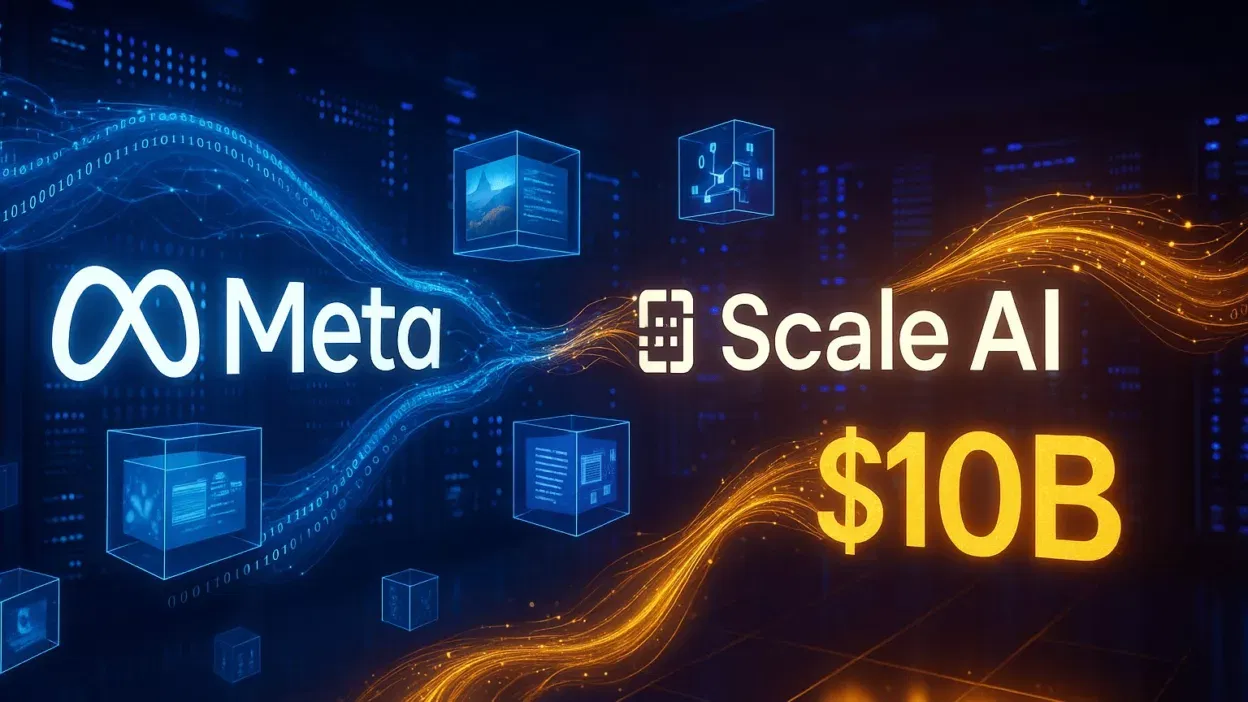Meta Platforms is reportedly in negotiations to invest more than $10 billion in Scale AI, the San Francisco-based data labeling company, in what would mark a seismic shift in the artificial intelligence industry’s competitive dynamics. The potential deal, first reported by Bloomberg News on June 8, 2025, would represent Meta’s largest-ever external AI investment and signal a fundamental change in how tech giants approach the critical challenge of AI training data.
The investment, which sources familiar with the matter say could exceed $10 billion, would value Scale AI significantly above its current $13.8 billion valuation from its May 2024 Series F round. While terms remain under negotiation and both companies have declined to comment, the strategic implications of this partnership extend far beyond the financial headlines. This move positions Meta to secure exclusive access to the most critical resource in AI development: high-quality training data.
The Rise of Scale AI: From MIT Dropout to AI Infrastructure Kingpin
Founded in June 2016 by then-19-year-old MIT dropout Alexandr Wang and co-founder Lucy Guo, Scale AI has emerged as the dominant force in AI data infrastructure. Wang, whose parents were physicists at Los Alamos National Laboratory, left MIT after studying mathematics and computer science to build what he calls “the data foundry for AI.”
Scale AI’s journey from startup to essential AI infrastructure provider reflects the industry’s evolution. The company has raised $1.6 billion across seven funding rounds, with its valuation soaring from $1 billion in 2019 to $13.8 billion in 2024. Its investor roster reads like a who’s who of tech giants: Amazon, Meta, Nvidia, Microsoft, Intel Capital, AMD Ventures, and prominent venture firms including Accel, Index Ventures, and Founders Fund.
The company’s financial trajectory tells a story of explosive growth. Revenue jumped from $870 million in 2024 to a projected $2 billion in 2025, representing 130% year-over-year growth. This growth stems from Scale’s position as the critical infrastructure provider for virtually every major AI model, including those from OpenAI, Google, Microsoft, and Meta itself.
Scale’s comprehensive data engine powers the AI revolution
At its core, Scale AI operates a sophisticated data labeling and curation platform that combines artificial intelligence with a global workforce of over 100,000 contractors. The company’s Scale Data Engine handles everything from image and video annotation to complex natural language processing tasks, while its Scale Generative AI Platform provides reinforcement learning from human feedback (RLHF) services essential for training large language models.
Scale’s client list extends beyond Silicon Valley to include automotive giants like General Motors and Toyota, enterprise companies like PayPal and SAP, and increasingly, government entities. The company’s defense contracts, including the recently awarded Thunderforge program with the Department of Defense, demonstrate its expansion into national security applications. A five-year partnership with Qatar’s government, signed in February 2025, further illustrates Scale’s global ambitions.
Meta’s $65 Billion AI Infrastructure Gambit
Meta’s potential investment in Scale AI represents just one piece of CEO Mark Zuckerberg’s ambitious AI strategy. The company has committed to spending between $60-65 billion on AI infrastructure in 2025 alone, up from $38-40 billion in 2024. This investment includes plans for a massive 2-gigawatt data center – large enough to “cover a significant part of Manhattan” – and the deployment of 1.3 million GPUs by year’s end.
The social media giant’s AI journey began in December 2013 with the founding of Facebook AI Research (FAIR), led by Turing Award winner Yann LeCun. Since then, Meta has established itself as a major force in AI research and development, with groundbreaking contributions including the PyTorch machine learning framework, now the industry standard for deep learning research.
Open source philosophy drives Meta’s AI strategy
Meta’s most significant AI achievement has been its Llama series of large language models. The latest iteration, Llama 4, released in April 2025 with Scout and Maverick variants, continues Meta’s commitment to open-source AI development. The models have been downloaded hundreds of millions of times and power AI features across Meta’s platforms, serving over 1 billion monthly users through Facebook, Instagram, and WhatsApp.
This open-source philosophy distinguishes Meta from competitors like OpenAI and Google, who maintain proprietary models. As Zuckerberg stated in Meta’s latest earnings call, the goal is to “make Llama the industry standard worldwide” and prevent vendor lock-in that could stifle innovation. The company’s other open-source contributions include Detectron2 for computer vision, fastText for natural language processing, and the revolutionary Segment Anything Model (SAM) for image segmentation.
Meta’s AI infrastructure investments extend beyond software to include custom silicon development, with its MTIA v1 AI accelerator, and contributions to the Open Compute Project’s Grand Teton GPU hardware platform. The company’s diverse hardware strategy includes a mix of Nvidia, AMD, and custom chips, with plans for “600,000 H100 equivalents” in its computing arsenal.
The Data Crisis Driving Billion-Dollar Deals
The strategic rationale behind Meta’s potential Scale AI investment becomes clear when examining the AI industry’s most pressing challenge: the impending data scarcity crisis. According to research firm Epoch AI, large language models will exhaust publicly available human-generated data between 2026 and 2032, creating what experts call the “data wall.”
This crisis has transformed high-quality training data from a commodity into a strategic asset. Studies demonstrate direct correlation between data quality dimensions – accuracy, completeness, and consistency – and model performance across machine learning algorithms. As models grow larger and more sophisticated, the marginal value of algorithmic improvements diminishes while data quality becomes paramount.
Scale AI’s moat in the data labeling market
Scale AI’s dominance in this critical market stems from several competitive advantages. The company’s end-to-end platform combines sophisticated software tools with a managed global workforce, ensuring consistent quality across petabyte-scale datasets. Its proprietary quality control mechanisms and evaluation frameworks, including the SEAL (Safety, Evaluation and Alignment Lab) Leaderboards, set industry standards for data quality assessment.
The company’s specialized expertise spans multiple domains crucial for next-generation AI applications. In autonomous vehicles, Scale provides complex LiDAR and sensor fusion annotation. For defense applications, it offers secure, classified data processing capabilities. Its synthetic data generation capabilities address privacy concerns while enabling training on rare or sensitive scenarios.
Scale’s projected revenue of $2 billion in 2025 significantly exceeds known competitors in the data labeling space. While companies like Labelbox, Appen, and SuperAnnotate compete in various niches, none match Scale’s combination of technological sophistication, operational scale, and strategic partnerships. Gartner projects the global data labeling market will grow from $3.77 billion in 2024 to $92.4 billion by 2034, representing a 22% compound annual growth rate.
Strategic implications reshape AI’s competitive landscape
Meta’s investment in Scale AI would fundamentally alter the competitive dynamics among tech giants racing for AI supremacy. The partnership directly challenges Microsoft’s $13 billion investment in OpenAI, Google’s billions invested in Anthropic, and Amazon’s $4 billion Anthropic stake. Unlike these competitors who invested in AI model companies, Meta’s approach targets the critical infrastructure layer.
Vertical integration creates sustainable competitive advantages
By potentially securing exclusive or preferential access to Scale’s data labeling capabilities, Meta could achieve several strategic objectives. First, it would ensure consistent, high-quality training data for future Llama models, potentially surpassing the data quality available to competitors. Second, integrated data pipelines would reduce training costs and time-to-market for new models. Third, direct control over data preparation enables experimentation with novel training methodologies that competitors cannot easily replicate.
The existing Defense Llama collaboration between Meta and Scale AI provides a preview of potential synergies. This military-focused version of Meta’s language model, available exclusively in controlled U.S. government environments, demonstrates how the partnership could expand into new markets while maintaining security and compliance requirements.
Industry analysts view this potential investment as part of a broader consolidation trend in AI infrastructure. CB Insights reported a record 317 AI merger and acquisition deals in 2023, with major players increasingly choosing to acquire rather than build critical capabilities. The strategic value of data infrastructure has evolved from operational necessity to competitive differentiator.
The future of AI depends on who controls the data
Meta’s potential $10+ billion investment in Scale AI represents more than a financial transaction – it signals a fundamental shift in how the AI industry values and controls training data. As the race for artificial general intelligence intensifies, access to high-quality, diverse, and ethically sourced training data becomes the primary constraint on progress.
This investment would position Meta uniquely among tech giants, combining world-class AI research capabilities, massive computational infrastructure, and now potentially exclusive access to premium data labeling services. The integration of Scale’s synthetic data generation capabilities could prove particularly valuable as natural data sources become exhausted.
For the broader AI ecosystem, this deal raises important questions about market concentration and competitive dynamics. If completed, it would create a vertically integrated AI powerhouse spanning from data collection through model training to consumer deployment across billions of users. Smaller AI companies might find themselves increasingly dependent on partnerships with tech giants for access to essential data infrastructure.
A defining moment in AI’s evolution
As negotiations continue, the potential Meta-Scale AI partnership represents a watershed moment in artificial intelligence development. The deal acknowledges that sustainable AI leadership requires more than brilliant algorithms and massive computing power – it demands control over the entire data pipeline from collection to deployment.
For Meta, this investment could secure its position as a leader in open-source AI while building competitive moats that closed-model competitors cannot easily replicate. For Scale AI, partnership with Meta would provide resources to accelerate its vision of becoming the essential data infrastructure for all AI development. For the industry, this deal may mark the beginning of a new phase where data infrastructure companies become as valuable and strategic as the AI model developers themselves.
The implications extend beyond corporate strategy to fundamental questions about AI development. As Yann LeCun, Meta’s Chief AI Scientist, has argued, current approaches to AI may become “obsolete within 5 years.” Securing control over data infrastructure positions Meta to pioneer whatever paradigms emerge next, whether world models, embodied AI, or approaches yet to be conceived.
In the high-stakes race for AI supremacy, Meta’s potential bet on Scale AI demonstrates that the companies controlling the picks and shovels – the essential infrastructure of data preparation – may prove as valuable as those mining for AI gold. As the industry awaits official confirmation of this historic deal, one thing remains clear: the future of AI will be determined not just by who has the best models, but by who controls the data that makes those models possible.






